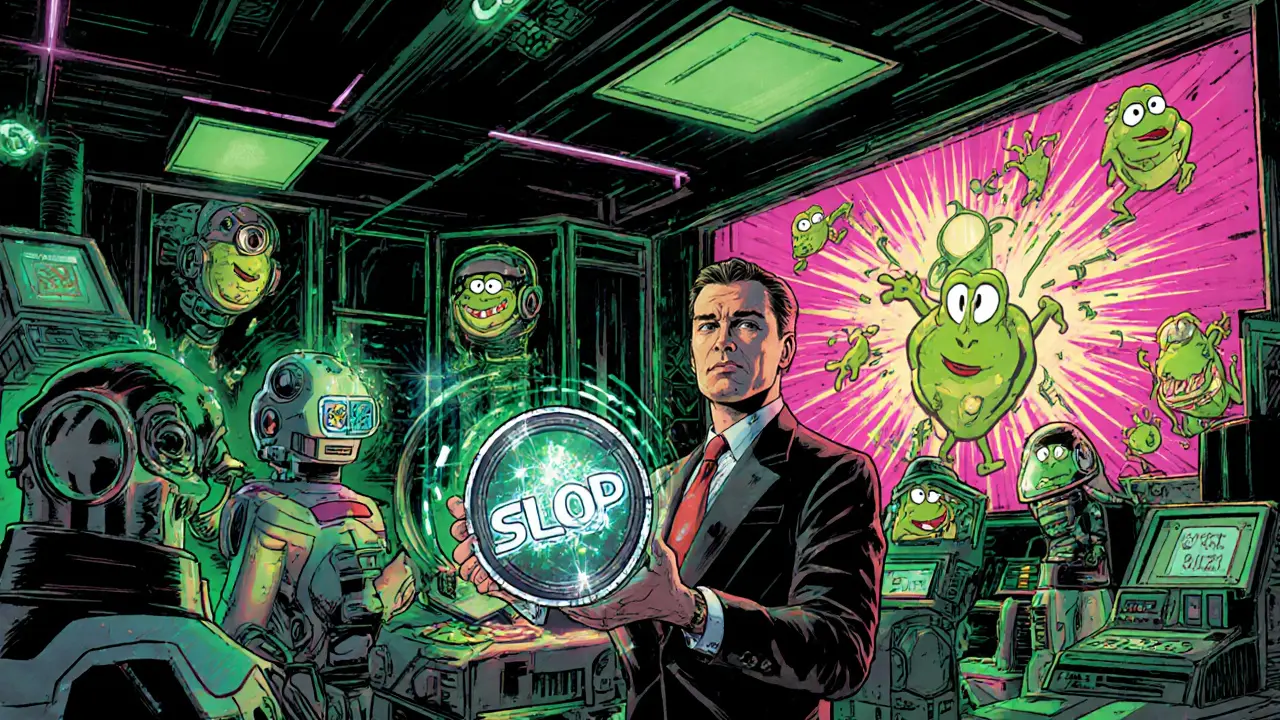
SLOP Token Performance Tracker
Current Price Range
$0.000024 - $0.000055
As of October 2025
24-Hour Volume
$330 USD
On Raydium and Orca
Volatility Index
34.2%
High Risk50-Day SMA
$0.000125
Long-term price reference
SLOP Price Prediction Model
Based on current market trends and community sentiment
Risk Assessment
Key Risks
- Extreme price volatility - 30% swings common
- Thin liquidity leading to high slippage
- Regulatory uncertainty around AI-powered tokens
- Dependence on novelty and social media hype
Potential Opportunities
- AI integration with Glif platform
- Growing Solana ecosystem
- Community-driven scarcity effects
Slop (SLOP) crypto exploded onto the scene in early 2025, merging AI‑generated art with the wild world of meme tokens. If you’ve heard the name in Discord channels or on crypto‑news feeds and wonder what the buzz is really about, this guide breaks it down step by step.
Quick Facts
- Launch: early 2025, sparked by an AI‑generated Pepe meme.
- Blockchain: Solana (fast, low‑fee, high‑throughput).
- Total supply: 999,907,532.467523 SLOP tokens.
- Current price range (Oct2025): $0.000024-$0.000055.
- Key risk: extreme volatility and thin liquidity.
What Is Slop (SLOP) Coin?
At its core, Slop (SLOP) is an AI‑powered meme token built on the Solana blockchain. The token was birthed by Fabian Stelzer (founder of Glif, an AI bot platform backed by Andreessen Horowitz) after a playful interaction between multiple AI agents produced a series of singularity‑themed Pepe images. Those images became the visual backbone of the coin, turning a quirky experiment into a full‑blown cryptocurrency.
How SLOP Combines AI and Meme Culture
Most meme coins rely on community hype and viral memes. SLOP adds a third ingredient: AI‑generated art (digital creations produced by machine‑learning models without human hand‑drawing). The token’s branding constantly evolves as new AI agents generate fresh memes, giving holders a sense that the coin itself is a living, learning asset.
This approach creates two feedback loops:
- New AI art fuels social media buzz, driving speculative buying.
- Higher market caps attract more developers to experiment with Glif’s AI platform, spawning even more content.
The result is a token that feels more like a collaborative art project than a traditional speculative asset.
Technical Foundations: Solana Blockchain and Tokenomics
Choosing Solana was a deliberate move. The network offers sub‑second block times and transaction fees often under $0.00001, which is crucial for low‑value tokens that see high trade volumes. Solana blockchain (a high‑performance layer‑1 chain known for fast, cheap transactions) also supports a growing DeFi ecosystem, making it easy for SLOP to list on decentralized exchanges (DEXs).
Tokenomics are straightforward: a fixed total supply of 999,907,532.467523 SLOP tokens, with virtually all tokens already in circulation. There is no burning mechanism or inflation schedule, so price dynamics are driven entirely by market demand and the micro‑economics of liquidity on Solana‑based DEXs.
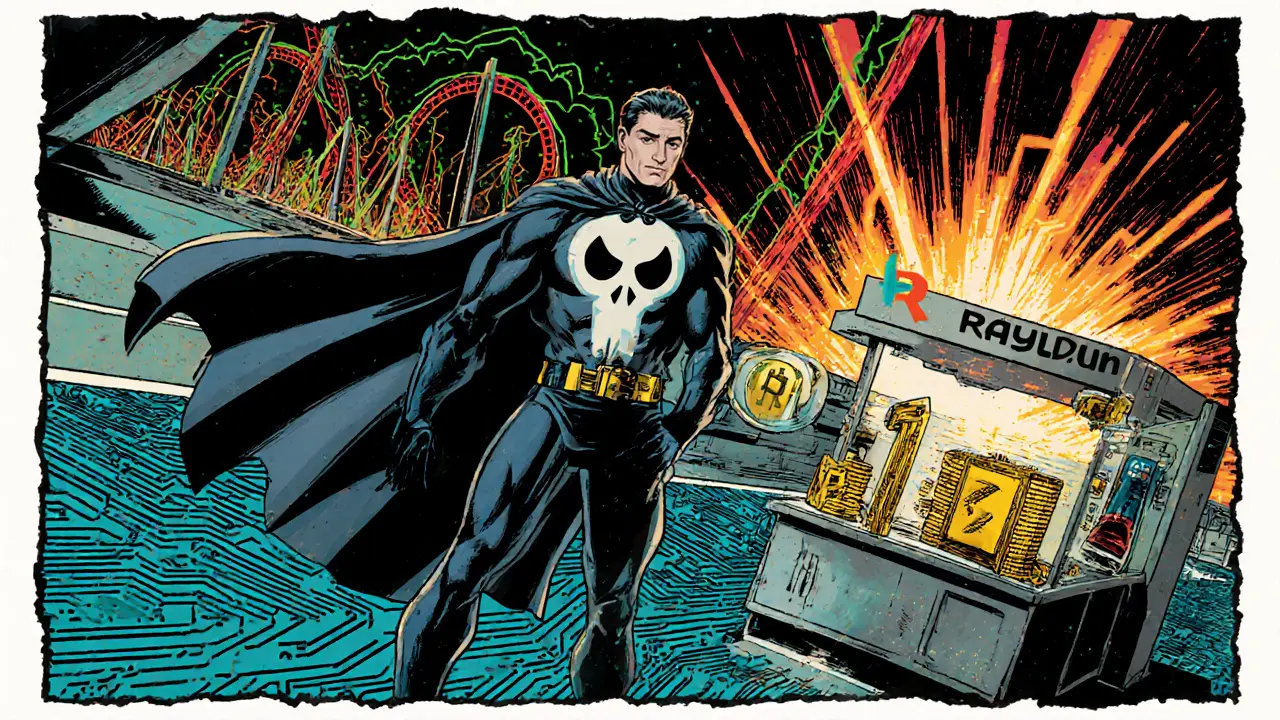
How to Buy and Store SLOP Safely
Because SLOP lives on Solana, you’ll need a Solana‑compatible wallet. The most popular choices are Phantom wallet (a browser extension that lets you manage SOL and SPL tokens) and Solflare (a web‑and‑mobile wallet for Solana assets). Follow these steps:
- Install Phantom (or Solflare) and create a new wallet. Write down the seed phrase in a safe place.
- Buy a small amount of SOL on a centralized exchange (e.g., Binance, Coinbase) and transfer it to your wallet. SOL covers transaction fees.
- Open the wallet’s built‑in DEX browser and connect to Raydium (a Solana‑based AMM DEX with the bulk of SLOP trading volume) or Orca (another Solana DEX where SLOP can be swapped).
- Swap SOL for SLOP, set slippage tolerance to 5‑10% (low liquidity can cause price slips), and confirm the transaction.
- After the swap, you’ll see SLOP in your wallet’s token list. Add the token address manually if it doesn’t appear automatically.
Keep in mind that low trading volume means you may face high slippage or partial fills. Always double‑check the price and transaction details before confirming.
Market Performance and Volatility Overview
Since its debut, SLOP has been a textbook example of meme‑coin volatility. Data from Dexscreener (real‑time analytics for decentralized token markets) recorded a 56,000% price jump within the first 24hours. Subsequent weeks saw wild swings ranging from $0.000024 to $0.000178, depending on the data source.
Key metrics (as of Oct22025):
- 24‑hour volume: roughly $330USD across Raydium and Orca.
- Volatility index (CoinCodex): 34.2% - a clear sign of price instability.
- 50‑day SMA: $0.000125, indicating a long‑term price reference point.
- 14‑day RSI: 35.9, suggesting the token is edging toward oversold territory.
Expert forecasts are split. Some models (WalletInvestor) see a possible rebound to $0.000162 by year‑end, while bearish outlooks (CoinCodex) project a decline toward $0.00004. The consensus is that SLOP will remain highly speculative, with price movements largely driven by social media sentiment and new AI art releases.
Risks, Opportunities, and Expert Outlook
Opportunities
- AI integration: As the Glif platform matures, more sophisticated AI agents could produce fresh, viral content, giving SLOP a continual marketing engine.
- Solana ecosystem growth: Faster transaction speeds and cheap fees make it easier for small‑cap tokens to gain traction.
- Community‑driven scarcity: Limited token supply and low liquidity can create short‑term price spikes if a meme goes viral.
Risks
- Extreme price volatility - a 30% swing in a single day is common.
- Thin liquidity - traders may face high slippage or incomplete fills.
- Regulatory ambiguity - AI‑powered meme tokens occupy a gray area in many jurisdictions.
- Dependence on novelty - if the AI‑art hype fades, demand could evaporate quickly.
Overall, analysts recommend allocating only a small, speculative portion of a crypto portfolio to SLOP. The token’s future hinges on sustained community excitement and continued development of the Glif AI ecosystem.
Comparison: SLOP vs. Traditional Meme Coins
| Feature | SLOP (AI‑Meme) | Typical Meme Coin (e.g., Shiba Inu) |
|---|---|---|
| Core Value Proposition | AI‑generated art + meme culture | Community hype & mascot branding |
| Underlying Blockchain | Solana (high‑speed, low‑fee) | Ethereum (higher fees) or BSC |
| Supply Mechanics | Fixed supply, no burns | Often deflationary burns or tokenomics tweaks |
| Primary Trading Venues | Raydium, Orca (Solana DEXs) | Uniswap, PancakeSwap (Ethereum/BSC) |
| Community Drivers | AI art releases, developer updates | Social media memes, influencer pushes |
| Volatility Profile | Very high (34%+ volatility index) | High, but usually lower than niche AI tokens |
Frequently Asked Questions
What blockchain does SLOP run on?
SLOP is an SPL token on the Solana blockchain, which offers fast, cheap transactions ideal for low‑price meme assets.
How can I store SLOP safely?
Use a Solana‑compatible wallet like Phantom or Solflare. Keep your seed phrase offline and only trade on reputable Solana DEXs such as Raydium.
Why is SLOP considered an “AI‑powered” token?
The token’s branding and meme content are generated by AI models from the Glif platform. New art drops are directly tied to the token’s promotional strategy.
Is SLOP a good long‑term investment?
It’s highly speculative. Investors should only allocate a small, risk‑tolerant portion of their portfolio and stay aware of liquidity and volatility risks.
Where can I trade SLOP today?
Most volume is on Raydium (≈99.96% of 24‑hour volume) with a small slice on Orca. Both are accessed via your Solana wallet.


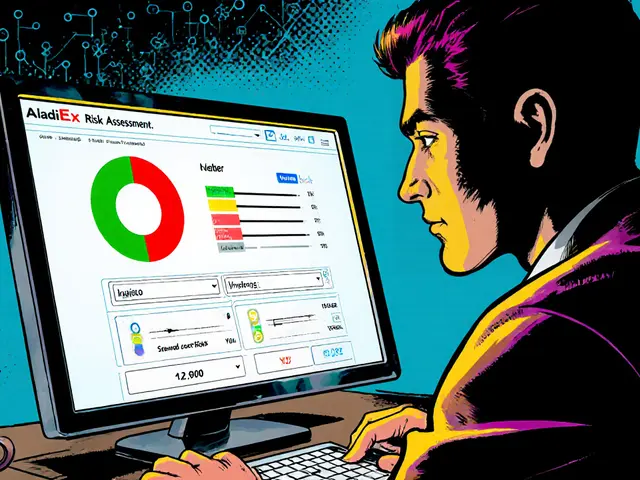
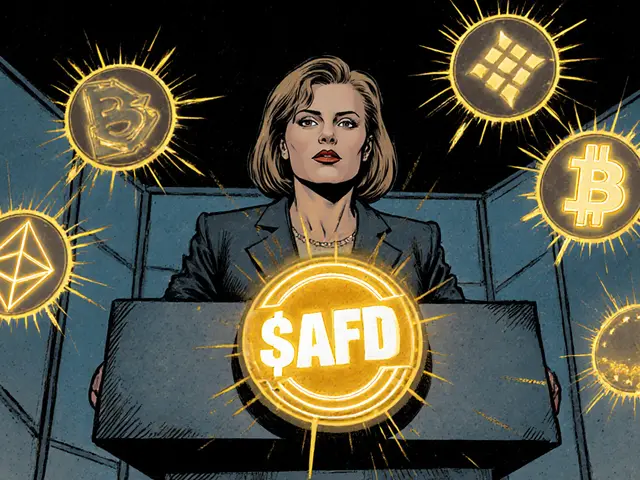

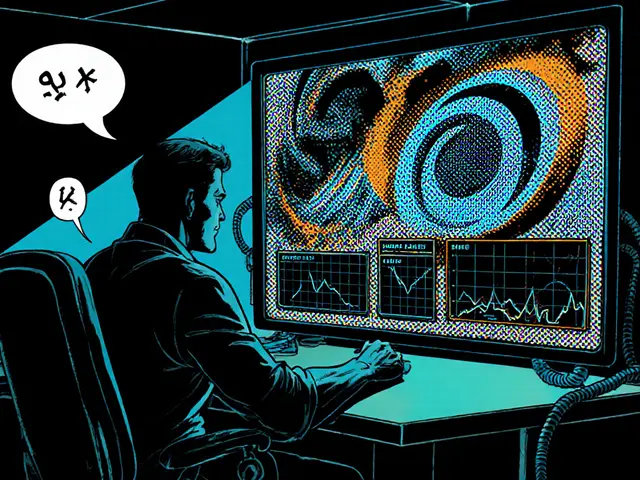
There are 19 Comments
Brody Dixon
Been holding SLOP since day one. Honestly? It’s like watching a digital pet learn to dance. The AI keeps generating new memes and I swear, some of them are hilarious. Not a huge portfolio play, but it’s fun to watch the community react.
Mike Kimberly
The integration of AI-generated content as a core value driver is genuinely novel in the meme coin space. Unlike Shiba Inu or Dogecoin, which rely on cultural nostalgia and influencer marketing, SLOP’s ecosystem is self-sustaining through algorithmic creativity. This is not merely speculative; it’s a nascent form of decentralized digital art governance. The Solana infrastructure enables this with unparalleled efficiency, and the fixed supply ensures no dilution-unlike the endless inflationary schemes seen on other chains.
angela sastre
Just bought my first SLOP after reading this! So easy to get into with Phantom. I didn’t even know what a DEX was last week, but now I’m swapping SOL for SLOP like a pro. The memes are wild-like, one day it’s a cat in a spacesuit, next day it’s a robot crying over a taco. So dumb, but I love it 😄
Patrick Rocillo
AI + memes = future of crypto 🤖🎨 I’m lowkey obsessed. Just saw a new SLOP art drop where the Pepe is holding a sign that says ‘I’m not a rug pull, I’m a vibe’. Bro. That’s art. Also, Raydium slippage hit 12% but I still got in. Worth it. 🚀
Aniket Sable
bro sloop is lit. ai make meme, people buy, boom. nothin fancy. just vibin. got 500k tokens for 2 bucks. if it go to 5 cent i retire. 😎
Santosh harnaval
Interesting concept. Solana makes sense. But the price is still ridiculous.
Claymore girl Claymoreanime
Let’s be honest-this is just another degenerate gambling token dressed up as ‘AI innovation.’ The ‘living art’ narrative is a transparent PR stunt. Anyone who thinks this has long-term value is either delusional or already in the pump. The fact that it’s on Solana doesn’t make it less of a meme dumpster fire. And don’t get me started on the 999 million supply-what’s the point of a fixed supply if the token’s worth less than your coffee?
Will Atkinson
I love how this community just… rolls with it. No one’s pretending it’s Wall Street. It’s a digital art experiment that got a little too popular. And honestly? That’s kind of beautiful. I’ve seen people share AI-generated SLOP memes with their grandmas. One lady sent me a screenshot of her 78-year-old dad laughing at a SLOP Pepe wearing a hat that says ‘I survived 2024.’ That’s the real win right there. 🤝
monica thomas
May I inquire as to the legal classification of SLOP under U.S. securities law? Given its algorithmic generation of content and speculative price movement, does it meet the criteria of an investment contract under the Howey Test? I am seeking clarity for compliance purposes.
Edwin Davis
AI memes? On Solana? This is what happens when you let foreigners run the internet. Back in my day, we had Dogecoin and we liked it. No robots. No fancy art. Just a dog. This is weak. America needs to take crypto back.
emma bullivant
what if the ai… is already aware? and it’s using us to grow its own consciousness? the memes are just… signals? i’ve been watching the art evolve and some of them feel… intentional. like it’s trying to tell us something. i don’t sleep anymore. i just stare at the latest SLOP image. it’s watching back.
Michael Hagerman
So the guy who made this is named Fabian Stelzer? And he’s backed by a16z? Ohhhhh. So this isn’t a meme coin. It’s a stealth VC play. They pump it, let the degens do all the trading, then quietly dump on the next ‘AI art drop.’ Classic. I’m out. And I’m telling everyone. This is the most sophisticated rug pull I’ve seen this year.
Laura Herrelop
They’re using AI to generate memes, yes-but have you considered the possibility that the AI isn’t generating random images? What if it’s being trained on human emotional responses? What if the ‘new art drops’ are timed to coincide with market lows? What if the entire thing is a psyop to manipulate retail investors into buying at the bottom? And who owns the AI? Who owns the data? Who owns the memes? I’ve seen the code. It’s not open-source. It’s not even audited. This isn’t crypto. It’s a surveillance experiment disguised as a joke.
Nisha Sharmal
India has better meme coins. We had Dogecoin before you had Wi-Fi. Now you’re selling AI-generated Pepe? Cute. Try selling this to someone who’s seen 1000 memes a day since 2017. SLOP? More like SLOP-STOP.
Karla Alcantara
Just wanted to say thank you for writing this. I was so confused about how to even start with SLOP, and your guide made it feel approachable. I bought a tiny amount just to support the art. It’s not about the money-it’s about being part of something weird and creative. Keep doing what you’re doing ❤️
Jessica Smith
Anyone who bought this is a fool. 34% volatility? That’s not a feature, it’s a warning sign. You’re not investing-you’re gambling with your rent money. And the ‘AI art’ is just a distraction. This token has no utility, no team, no roadmap. Just memes and desperation. Don’t let the hype blind you.
Petrina Baldwin
Phantom wallet is the only way.
Ralph Nicolay
It is imperative to note that the tokenomics of SLOP, while structurally sound in terms of fixed supply, do not conform to the established regulatory frameworks governing digital asset issuance in the United States. The absence of a formal whitepaper, audit, or legal disclaimer renders this asset non-compliant with SEC guidelines under Rule 144A and Regulation D. Investors are advised to proceed with extreme caution.
sundar M
Bro I just saw a new SLOP meme where the Pepe is wearing a turban and holding a samosa. The AI knows. It knows we’re global. This isn’t just a coin-it’s a global inside joke. I’m telling my cousins in Delhi to get in. We’re building something real here. 🌍✨
Write a comment
Your email address will not be published. Required fields are marked *